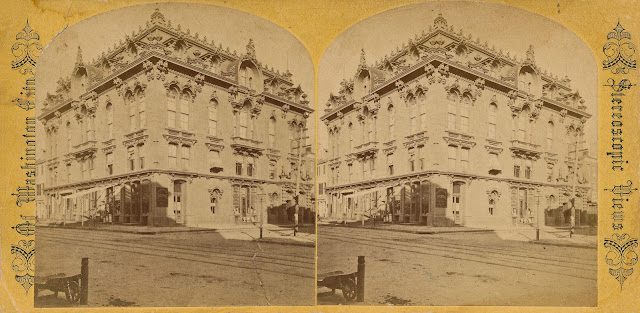Briefly noted: Lincoln Hall
Today's post focuses on these old stereographs of Lincoln Hall, which was located on the northeast corner of 9th and D Streets NW from 1867 to 1886.
According to James Goode, Lincoln Hall was "one of the finest auditoriums in the Nation's Capital during the nineteenth century," a pre-cursor to the Kennedy Center. The ornate building was put up by a group of organizations including the YMCA in 1867. The Grand Army of the Republic, a Union Army veterans group, used the third floor of the building before they built their own meeting hall on Pennsylvania Avenue opposite the Willard Hotel.
Lincoln Hall was destroyed by a devastating fire at 2 in the morning on a snowy December night in 1886. The fire began in a dressing room under the stage, which was filled with opera scenery. "The canvas scenery covered with oily paint and stretched on light frames of the driest vine ignited like tinder at the first stray spark," the Washington Post recounted, waxing poetic as it often did in such situations. "The ground was covered with a pure white sheet of snow, which reflected back the flames with dazzling brilliancy. The white flakes falling through the air were tinged with red, and by their side there floated downward in a great shower the red-hot cinders from the burning building...."
The Evening Star was more sanguine: "Now that Lincoln Hall has finally burned down, the people of Washington will take a breath of relief," it editorialized. "It was doubtless the worst planned building for exhibition purposes that ever was constructed, and had a fire or panic occurred while an entertainment was in progress it would have been almost, if not wholly, impossible for a dozen persons to escape from it alive.... If there is any authority to prevent it, no such structure ought to be allowed in the city again."
After the fire, the ruins were cleared away, and in 1890 another auditorium, the Academy of Music, was constructed and remained there until the 1950s. Whether it met the Star's safety standards is unknown.
As seen in the stereoview, Lincoln Hall was extravagantly ornamented, perhaps surpassing even the Old Executive Office Building in its excess. Goode notes that the ornamentation may have been "in questionable architectural taste," but at least it provided whimsical delight to passersby. As Goode concludes, "Present-day Washington pedestrians are allowed few such pleasures to the eye on K Street, where the recent architecture is of little more interest than a row of over-scaled filing cabinets."
Sources: James M. Goode, Capital Losses (2003), p. 403, and newspaper articles.
 |
| Two undated stereoviews of Lincoln Hall (author's collection). |
According to James Goode, Lincoln Hall was "one of the finest auditoriums in the Nation's Capital during the nineteenth century," a pre-cursor to the Kennedy Center. The ornate building was put up by a group of organizations including the YMCA in 1867. The Grand Army of the Republic, a Union Army veterans group, used the third floor of the building before they built their own meeting hall on Pennsylvania Avenue opposite the Willard Hotel.
Lincoln Hall was destroyed by a devastating fire at 2 in the morning on a snowy December night in 1886. The fire began in a dressing room under the stage, which was filled with opera scenery. "The canvas scenery covered with oily paint and stretched on light frames of the driest vine ignited like tinder at the first stray spark," the Washington Post recounted, waxing poetic as it often did in such situations. "The ground was covered with a pure white sheet of snow, which reflected back the flames with dazzling brilliancy. The white flakes falling through the air were tinged with red, and by their side there floated downward in a great shower the red-hot cinders from the burning building...."
The Evening Star was more sanguine: "Now that Lincoln Hall has finally burned down, the people of Washington will take a breath of relief," it editorialized. "It was doubtless the worst planned building for exhibition purposes that ever was constructed, and had a fire or panic occurred while an entertainment was in progress it would have been almost, if not wholly, impossible for a dozen persons to escape from it alive.... If there is any authority to prevent it, no such structure ought to be allowed in the city again."
 |
| Lincoln Hall after the fire (Source: Library of Congress). |
After the fire, the ruins were cleared away, and in 1890 another auditorium, the Academy of Music, was constructed and remained there until the 1950s. Whether it met the Star's safety standards is unknown.
As seen in the stereoview, Lincoln Hall was extravagantly ornamented, perhaps surpassing even the Old Executive Office Building in its excess. Goode notes that the ornamentation may have been "in questionable architectural taste," but at least it provided whimsical delight to passersby. As Goode concludes, "Present-day Washington pedestrians are allowed few such pleasures to the eye on K Street, where the recent architecture is of little more interest than a row of over-scaled filing cabinets."
Sources: James M. Goode, Capital Losses (2003), p. 403, and newspaper articles.



So this appears to have been where The Caucus Room is now located. Would have made an interesting contrast to the brutalist FBI Headquarters that is now located across the street.
ReplyDeleteI love reading your posts, and want to thank you for the good writing and scholarship. I look forward to this informal education every two weeks.
ReplyDeleteBe blessed,
Marlene
Thanks Marlene!
Delete